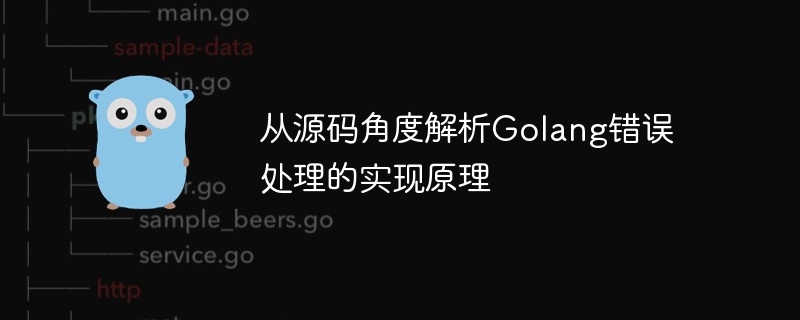Home >Backend Development >Golang >A deep dive into the underlying logic of Golang error handling
A deep dive into the underlying logic of Golang error handling
- WBOYWBOYWBOYWBOYWBOYWBOYWBOYWBOYWBOYWBOYWBOYWBOYWBOriginal
- 2024-02-25 13:39:06608browse

Golang is an open source programming language developed by Google and is widely used in web development, cloud computing and other fields. The error handling mechanism is particularly emphasized in the language design. When writing Go programs, reasonable handling of errors is crucial. This article will analyze the implementation principle of Golang error handling from the perspective of source code, and use specific code examples to help readers better understand the working principle of this mechanism.
In the Go language, error handling is implemented through the error interface. Error is an interface type, which is defined as follows:
type error interface {
Error() string
}Any type that implements the Error() method can be assigned to the error interface. Normally, when an error occurs during the execution of a function or method, a value of type error is returned, and whether an error occurs is determined by checking whether the value is nil.
The commonly used error handling method in Golang is to compare if statements and nil to determine whether there is an error, for example:
func divide(a, b int) (int, error) {
if b == 0 {
return 0, errors.New("division by zero")
}
return a / b, nil
}In the above example, if b is 0, a description will be returned The error type value of the error message. The caller can determine whether an error has occurred by determining whether the error is nil.
Golang’s built-in errors package provides a New function to easily create a new error. At the same time, Go also provides the fmt.Errorf function, which can format error information and return an error type value.
In the source code of Golang, the implementation of error handling mechanism is mainly concentrated in the runtime package and errors package. The runtime package provides panic and recovery mechanisms for error handling, while the errors package defines the standard error interface and some simple error handling functions.
Let’s take a look at the implementation principle of error handling in Golang.
1. Panic and recovery
In Golang, when the program encounters an error that cannot continue execution, the panic function can be used to throw an exception. Once a panic occurs, the program will immediately stop running, start looking up the call stack for the defer function, and execute the code in the defer function. At the same time, you can use the recover function to catch this exception and continue the execution of the program.
The following is a simple sample code:
func recoverDemo() {
defer func() {
if err := recover(); err != nil {
fmt.Println("Recovered:", err)
}
}()
panic("Something went wrong")
}
func main() {
fmt.Println("Start")
recoverDemo()
fmt.Println("End")
}In the above code, we use the defer keyword in the recoverDemo function to define an anonymous function, and use the recover function to capture in this function Exception and print error message. When the recoverDemo function is called in the main function, panic will be triggered. The program will catch this exception in the defer function and continue to execute subsequent code.
2. Errors package implementation
The errors package is one of the standard packages for error handling in Golang, which defines an error interface type and some commonly used error handling functions. The following is the definition in the errors package:
package errors
type errorString struct {
s string
}
func (e *errorString) Error() string {
return e.s
}
func New(text string) error {
return &errorString{text}
}The errorString type is defined in the errors package, which implements the Error method of the error interface, and the New function is used to create a new error.
3. Use custom error types
In addition to using the errorString provided by the errors package, we can also customize error types to achieve more personalized error handling. The following is a sample code:
type DivideError struct {
dividend int
divisor int
}
func (e *DivideError) Error() string {
return fmt.Sprintf("cannot divide %d by %d", e.dividend, e.divisor)
}
func divide(a, b int) (int, error) {
if b == 0 {
return 0, &DivideError{a, b}
}
return a / b, nil
}In the above code, we define a custom DivideError type and implement the Error method of the error interface. In the divide function, when the divisor is 0, an error value of type DivideError will be returned.
Through the above code examples and analysis, we can have a clearer understanding of the implementation principle of error handling in Golang. In actual development, reasonable error handling is an important means to improve the robustness and reliability of the program. We hope that readers can fully understand the error handling mechanism and perform appropriate error handling when writing Go programs.
The above is the detailed content of A deep dive into the underlying logic of Golang error handling. For more information, please follow other related articles on the PHP Chinese website!

